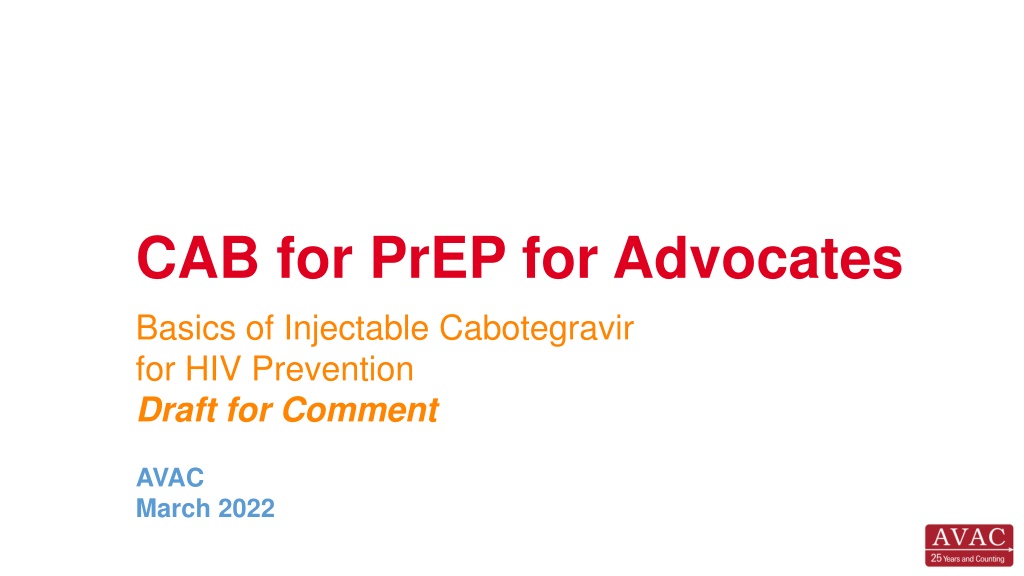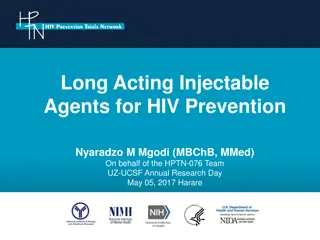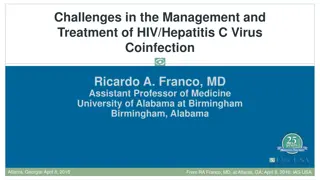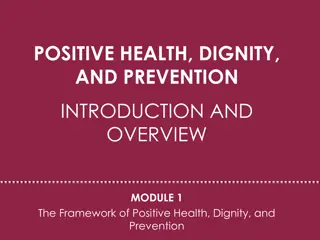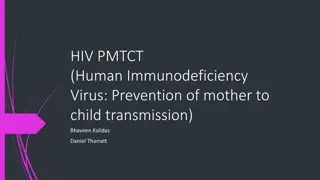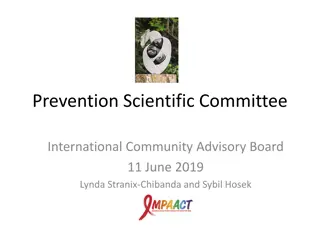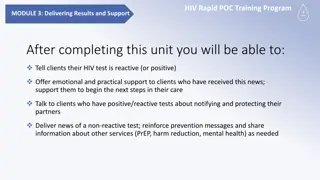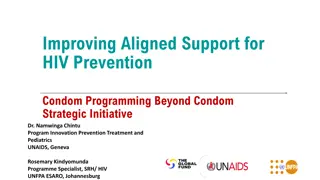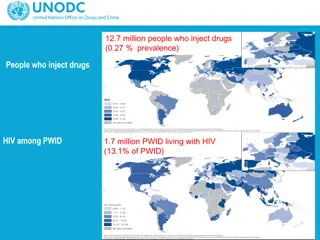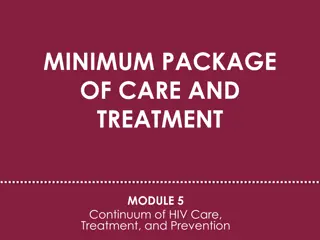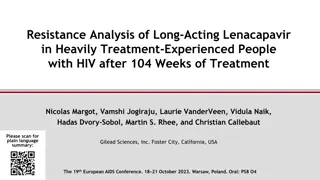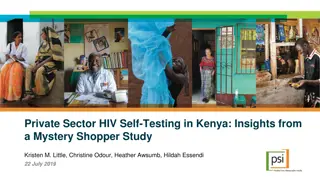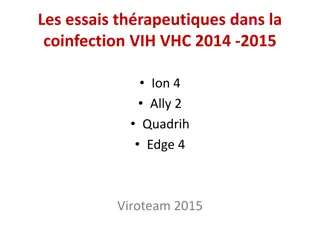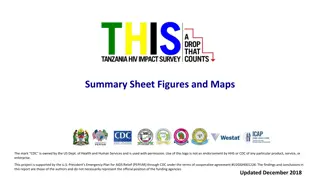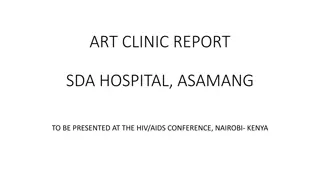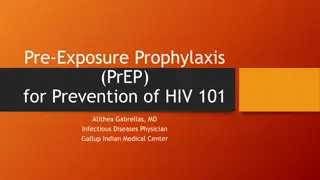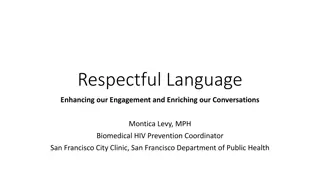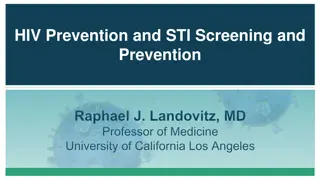Comprehensive Overview of Injectable Cabotegravir for HIV Prevention
Injectable Cabotegravir is an effective form of an integrase strand transfer inhibitor for HIV treatment and prevention. It has shown promising results in reducing the risk of HIV acquisition in men who have sex with men, transgender women, and cisgender women. The treatment involves regular injections and has been approved in Canada, Europe, and the US. However, barriers such as cost and cold chain requirements need to be addressed for widespread use.
Download Presentation

Please find below an Image/Link to download the presentation.
The content on the website is provided AS IS for your information and personal use only. It may not be sold, licensed, or shared on other websites without obtaining consent from the author. Download presentation by click this link. If you encounter any issues during the download, it is possible that the publisher has removed the file from their server.
E N D
Presentation Transcript
CAB for PrEP for Advocates Basics of Injectable Cabotegravir for HIV Prevention Draft for Comment AVAC March 2022
Outline What is cabotegravir (CAB)? Treatment Prevention Clinical research What users think Regulatory and guidelines Preparing for implementation: Delivery Channels, Testing, Cost Advocacy
What is Injectable Cabotegravir? Quick look Injectable form of an integrase strand transfer inhibitor anti-retroviral, and an analogue of dolutegravir Nano-formulated, low-solubility crystalline drug suspended in an aqueous solution Developed by ViiV Healthcare, pharmaceutical company specializing in HIV therapies founded in 2009 by GSK & Pfizer Used in combination with injectable rilpivirine from J&J as a treatment (called Cabenuva) Two HIV prevention efficacy trials, under the HPTN, compared CAB injections every two months to daily oral TDF/FTC Shown to be very effective in men who have sex with men, transgender women and cisgender women
CAB for HIV Treatment: Summary Effective with rilpivirine as combination ART Approved to maintain viral suppression in people who have already demonstrated viral suppression using oral ARTs Delivered via two injections (one CAB and one RPV) in the buttocks every one or two months Administered by health care professional Injections begin after 1 month of daily oral cabotegravir/ rilpivirine to ensure no drug reactions Approved by regulators in Canada (2020), Europe (2020) and US (2021) Annual cost in US for both injections appx US$50,000 Not yet in widespread clinical use, and not currently part of WHO guidelines or PEPFAR and Global Fund procurement Required cold chain for rilpivirine and cost among the barriers in LMIC
CAB for Prevention: Summary Effective in preventing HIV acquisition Two clinical efficacy trials show that CAB is effective at substantially lowering risk of HIV acquisition in MSM, TGW and cisgender women Study participants in control arm received daily oral TDF/FTC Both injectable and oral PrEP strategies were safe and effective in significantly reducing risk of HIV acquisition Injections delivered every two months in buttocks by study nurses at research clinics Does not prevent other sexually transmitted infections or unintended pregnancy Safety studies in specific populations and open-label extensions ongoing Implementation research and demonstration studies in development
CAB for HIV PrEP Compared to Contraception Injectable Cabotegravir for HIV PrEP Gluteal muscle (buttocks) Every 2 months 3 mL DMPA-IM for Contraception Upper arm or gluteal muscle (buttocks) Every 3 months 1ml Injection Location Frequency Volume
CAB for HIV PrEP Efficacy Trials Design Two efficacy trials with similar designs HPTN 083 enrolled MSM and TGW HPTN 084 enrolled cisgender women Double dummy, double blind All participants receive injections AND oral tablets, and randomly assigned to 1 of 2 groups: Group A active CAB injection and placebo tablet Group B placebo injection and active oral TDF/FTC tablet Participants in active CAB arm take oral CAB for 5 weeks prior to injection to ensure no adverse reactions
Efficacy Trials: Summary Design/ Trial Questions Status (as of 2/22) Trial Participants Countries Key Results Non-inferiority design; comparing daily oral TDF/FTC to bimonthly injectable cabotegravir 4,570 Argentina, Brazil, Peru, South Africa, Thailand, US, Vietnam Ongoing; participants receiving product CAB superior to oral TDF/FTC in preventing acquisition of HIV HPTN 083 Cisgender gay men and other men who have sex with men (MSM); transgender women, 18 years and older Started December 2016 Open Label Extension started in some sites; others pending approvals Unblinded May 2020 following review by independent DSMB CAB reduced risk of infection by 66% compared with oral TDF/FTC 12% TGW 67.4% age 18-29 Superiority design; comparing daily oral TDF/FTC to bimonthly injectable cabotegravir 3,200 Botswana, Eswatini, Kenya, Malawi, South Africa, Uganda, Zimbabwe Ongoing; participants receiving product CAB superior to oral TDF/FTC in preventing acquisition of HIV HPTN 084 Started Cisgender women November 2017 Open Label Extension expected to start Q1 2022 57% age 18-25 Unblinded Nov 2020 following review by independent DSMB CAB reduced risk of infection by 89% compared with oral TDF/FTC As of February 2022; additional data still to come
Efficacy Trials: Status Independent Data Safety and Monitoring Boards (DSMB) for both trials recommended unblinding early when scheduled data reviews found studies had reached a conclusion about CAB efficacy for HIV prevention Placebo products dropped; participants can choose injectable CAB or oral TDF/FTC Analysis of blood samples showed most people in oral PrEP group who became HIV+ likely were not taking tablets consistently enough to provide protection Studies also showed that CAB is safe, with most reported side effects being reactions at the site of the injection These results in 2020 came around two years ahead of schedule so the timeline for all other actions needed for product access and delivery has accelerated
Efficacy Trials: Data Infections in CAB-LA Arm Infections in oral TDF/FTC Arm Hazard ratio in CAB LA vs. FTC/TDF arm Total Infections 0.32 HPTN 083 51 12 39 (95% CI 0.18-0.62) MSM and TGW Incidence 0.81% Incidence 0.37% Incidence 1.22% 66% risk reduction 0.11 HPTN 084 38 4 34 (95% CI 0.04-0.32) Cisgender women Incidence 1% Incidence 0.21% Incidence 1.79% 89% risk reduction
Ongoing Clinical Studies Open Label Extensions (OLE) Follow-on study with intervention available for a specific time to participants in the efficacy studies who know they are receiving active intervention with potential benefit Participants can choose injectable CAB or oral PrEP Continue data collection on safety, acceptability, and estimate incidence of HIV Starting late 2021/early 2022 as approvals granted and sites switch to new study Trial participants are continuing to receive oral or injectable PrEP before OLE starts Safety studies in different populations Young people: Two studies assessing safety, tolerability and acceptability of CAB among adolescents cisgender males and TGW in HPTN 083-01; cisgender females in HPTN 084-01 Pregnant and breastfeeding women: HPTN 084 participants who become pregnant can co- enroll in study examining ARVs and anti-TB medications in women living with HIV during and after pregnancy Acceptability and user perspectives Sub-study to evaluate factors that support or inhibit adherence and clinic visits for CAB, preferences and decision-making about using oral or injectable PrEP, and participants experiences in efficacy trial
What Do Participants Think of Injectable CAB? Overall most participants in HPTN 083 & 084 studies were satisfied with CAB, willing to continue to use it and would recommend to others Study comparing acceptability across different settings, and between men and women, found high overall acceptability Majority preferred injectable PrEP over oral tablets (63% in US; 93% non- US) Study population of US men preferred injectable over oral cabotegravir based on convenience, flexibility, lifestyle Other discreet choice experiments and user-center design studies have explored product preference, but not with actual products Additional information forthcoming from efficacy trials, open label extensions and implementation research
Regulatory and Guidelines: Status US Food and Drug Administration granted CAB for PrEP priority review Approved on December 20, 2021 ViiV prioritizing submissions to additional national regulatory authorities, starting with trial countries As of March 2022, submissions in Australia, Botswana, Brazil, Kenya, Malawi, South Africa, Zimbabwe Timelines for approvals dependent on national regulatory agencies US Centers for Disease Control and Prevention Guidelines Recommendation and guidance for CAB as PrEP included in revised PrEP guidelines issued December 2021 World Health Organization Guidelines Guideline development process underway; anticipated mid-2022
Preparing for Implementation Range of global health organizations are spearheading multiple workstreams to plan for introduction and delivery of injectable CAB for PrEP Work is being implemented rapidly given that the trials shifted to unblinding about two years earlier than anticipated Investment and coordination is needed across many sectors The following sections highlight some of the key issues related to delivery channels, testing and cost These are among the most pressing issues for the field, with opportunities and urgency for advocates to shape and monitor developments
Key Issues: Delivery Channels CAB is currently delivered in health clinics for treatment and study clinics for prevention Administered by health care workers Injection into the buttocks, requiring privacy within clinic Build on lessons from oral PrEP Simplify and de-medicalize delivery is key to access and uptake Provide in settings where clients including young people, MSM, TGW, FSW feel comfortable Offer as an option in the context of informed choice, whereby people can choose among different methods (oral PrEP, condoms, dapivirine ring, CAB) to find what works best for them Plan for clients to switch, stop or restart methods Integrate HIV prevention with sexual and reproductive health services Test and identify delivery innovations to increase access such as: Engage and inform potential users in places they prefer; explore delivering CAB in those settings Injections by trained community health workers or self-injection by clients Feasibility of other injection sites such as the thigh
Key Questions: Testing Throughout product development, there have been concerns about potential development of resistant virus Initial concerns centered on the long tail phase after a client stopped receiving injections and the drug was still present in the body but not at sufficient levels to prevent HIV infection Based on very limited data from 083, risk of resistance seems greater when people acquire HIV while taking CAB as prescribed than during the tail phase Timing of infections in 083 raised concerns about the whether standard HIV tests are sensitive in detecting HIV in people initiating PrEP Drawing on these data and PrEP implementation projects, revised testing protocols to be considered Testing protocols could have major impact on the cost and feasibility of CAB Need to determine the risks (possibly missed HIV+; false positives; resistance?) and benefits of different testing protocols Balance the information a testing protocol yields with feasibility (cost, logistics, burden on client and provider) A complex and costly testing protocol could effectively thwart availability of CAB in many settings with major equity considerations for access
Key Questions: Cost Cost of product Initial price of CAB for PrEP in the US over $22k/year, above price of branded oral PrEP Analyses suggest cost of CAB needs to be comparable to generic oral TDF/FTC to be cost effective compared to oral PrEP ViiV stated commitment to non-profit price for public programs in low- and middle-income countries, but no clarity on what that price is and how it compares to oral PrEP (currently $54/year) Ongoing uncertainty and lack of transparency around cost and pricing are an impediment to planning and advocacy Cost of programs Robust, well-designed PrEP programs need to include fully-costed and funded demand creation, provider training, testing and initiation, ongoing user support, M&E, etc. Testing protocols and requirements could be a key driver of the cost and complexity of delivering CAB in programs It is important for programs to invest in choice through offering multiple different product options, not only the lowest cost, easiest to deliver or perceived user, provider or system preference
How are Advocates Involved? Advocates and civil society are key actors in defining the evolving injectable CAB and comprehensive PrEP and prevention agendas by: Participating in community advisory groups to inform additional studies and implementation projects Providing expertise and consultation in priority setting and design of demonstration projects, policy strategies and implementation approaches Engaging with ViiV to advocate for equitable and urgent product availability, pricing, manufacturing and licensing arrangements Advocating with national health ministries and regulatory agencies for prompt action on product approvals and guidelines development Demanding funding from global, regional and national funders to support introduction and programming at scale Participating as key partners in ongoing discussions such as the AVAC/BioPIC/WHO think tanks to help determine priorities and define the implementation agenda
Advocacy Priorities to Shape the CAB Agenda Hold ViiV accountable for engaging with community and advocates, and responding to fair pricing and equitable access Monitor and advocate to ensure PEPFAR, Global Fund, national governments and other key donors plan and budget for comprehensive prevention through demanding funding, targets and innovation Work with WHO, UNAIDS and national health ministries and AIDS programs to ensure that CAB introduction plans are clear, include accountability and milestones, and have adequate funding to move forward with urgency Ensure civil society are partners and experts in planning for CAB, designing programs and delivery strategies, monitoring roll out and adapting to experience and evidence
For more information Contact AVAC at avac@avac.org to link up with other partners and advocates Subscribe to the PrEP Watch newsletter at www.prepwatch.org for new information, emerging ideas and priorities for action Advocates Primer on Injectable Cabotegravir for PrEP: Trials, Approvals, Rollout and More provides more in-depth information on some of the issues covered here Long-Acting Injectable Cabotegravir for PrEP - Understanding the results and key areas for advocacy: a webinar with the researchers and advocates leading on CAB-LA. HPTN 083, OLE and 083-01 https://www.hptn.org/research/studies/hptn083 HPTN 84, OLE and 084-01 https://www.hptn.org/research/studies/hptn084 Getting Rollout Right: Lessons from Oral PrEP Implementation Research Questions for CAB for PrEP, Dec 2021 HIV Testing and Injectable Cabotegravir for PrEP Think Tank Report, Dec 2021 Product Introduction Project Planning for Next-Generation PrEP Think Tank Report, Sept 2021
Thank You! This slide deck was developed as part of the Coalition to Accelerate and Support Prevention Research (CASPR) Cooperative Agreement No. AID-OAA-A-16-00031 HIV Vaccine and Biomedical Prevention Research Project Objective 3
